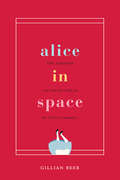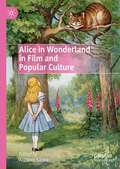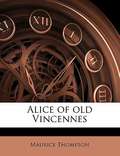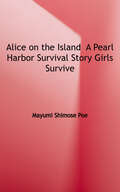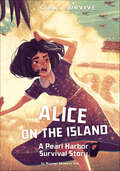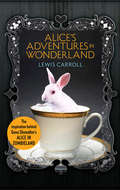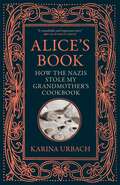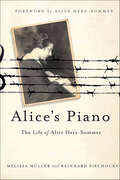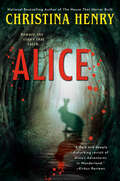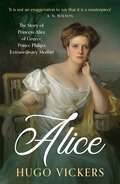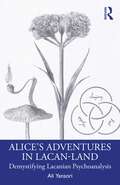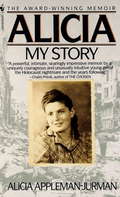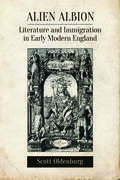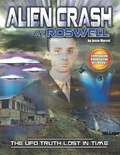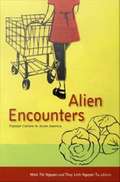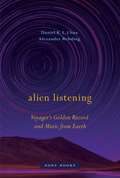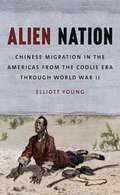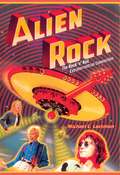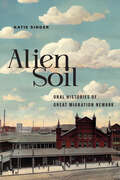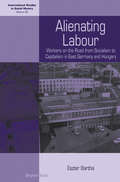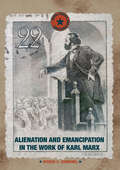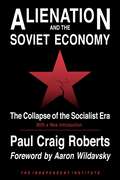- Table View
- List View
Alice in Space: The Sideways Victorian World of Lewis Carroll (Carpenter Lectures)
by Gillian BeerIn Alice's Adventures in Wonderland and Through the Looking-Glass, Lewis Carroll created fantastic worlds that continue to delight and trouble readers of all ages today. Few consider, however, that Carroll conceived his Alice books during the 1860s, a moment of intense intellectual upheaval, as new scientific, linguistic, educational, and mathematical ideas flourished around him and far beyond. Alice in Space reveals the contexts within which the Alice books first lived, bringing back the zest to jokes lost over time and poignancy to hidden references. Gillian Beer explores Carroll's work through the speculative gaze of Alice, for whom no authority is unquestioned and everything can speak. Parody and Punch, evolutionary debates, philosophical dialogues, educational works for children, math and logic, manners and rituals, dream theory and childhood studies--all fueled the fireworks. While much has been written about Carroll's biography and his influence on children's literature, Beer convincingly shows him at play in the spaces of Victorian cultural and intellectual life, drawing on then-current controversies, reading prodigiously across many fields, and writing on multiple levels to please both children and adults in different ways. With a welcome combination of learning and lightness, Beer reminds us that Carroll's books are essentially about curiosity, its risks and pleasures. Along the way, Alice in Space shares Alice's exceptional ability to spark curiosity in us, too.
Alice in Wonderland in Film and Popular Culture
by Antonio SannaThis book examines the many reincarnations of Carroll’s texts, illuminating how the meaning of the original books has been re-negotiated through adaptations, appropriations, and transmediality. The volume is an edited collection of eighteen essays and is divided into three sections that examine the re-interpretations of Alice in Wonderland and Through the Looking-Glass in literature, film, and other media (including the branches of commerce, music videos, videogames, and madness studies). This collection is an addition to the existing work on Alice in Wonderland and its sequels, adaptations, and appropriations, and helps readers to have a more comprehensive view of the extent to which the Alice story world is vast and always growing.
Alice of Old Vincennes
by Maurice ThompsonSet against the backdrop of the American Revolution Alice of Old Vincennes is the story of the orphan girl Alice Roussillon. In 1778 the French outpost of Vincennes, Indiana revolts against the British and swears allegiance to the American cause. <P> <P> Hoisting her hand-made American flag over the fort Alice provides the rallying symbol of the cause of liberty. The handsome Virginian Lt. Fitzhugh Beverly proves to be both a noble companion in arms as well as of the heart. When the British retake Vincennes the rallying cry Viva la banniere d'Alice Roussillon is heard throughout the land. The true battle for liberty and love has begun.
Alice on the Island: A Pearl Harbor Survival Story (Girls Survive Series)
by Mayumi Shimose PoeIn 1941, Alice's days are filled with swimming in the Hawaiian sea, going to school, and helping watch her younger siblings. But on December 7, everything changes when Japan bombs Pearl Harbor and brings the United States into World War II. Within hours Alice's father, a Japanese immigrant, is collected by authorities and sent to an internment camp. Meanwhile, Alice is left behind to face discrimination from former friends.
Alice on the Island: A Pearl Harbor Survival Story (Girls Survive)
by Mayumi Shimose PoeIn 1941, thirteen-year-old Alice's days are filled with swimming in the Hawaiian sea, going to school, and helping watch her younger siblings. But on December 7, everything changes when she experiences an act of war, the bombing of Pearl Harbor. As the United States enters World War II, Alice's father is sent to a Japanese internment camp, leaving Alice and the rest of her family struggling to adjust to life without him. Featuring nonfiction support material, a glossary, and reader response questions, this Girls Survive story takes readers to one of history's most important moments.
Alice's Adventures in Wonderland
by Lewis CarrollIt's been 150 years since Lewis Carroll penned Alice's Adventures in Wonderland, and Harlequin TEEN is celebrating this anniversary with a special new release of the beloved classic that inspired Gena Showalter's New York Times bestselling series The White Rabbit Chronicles. Don't miss this exclusive ebook edition, complete with a sneak peek at Alice in Zombieland.Imagine a fantastical place where rabbits wear pocket watches, hatters throw mad tea parties, cats give directions and nonsense abounds. Welcome to Wonderland, a world discovered by Alice when she tumbles down a rabbit hole on a hot summer day. Armed with courage and wit, Alice must solve countless riddles, argue with a caterpillar, play croquet with a queen and face all manner of unusual adventures in order to find her way home again.
Alice's Book: How the Nazis Stole My Grandmother's Cookbook
by Karina Urbach"Unputdownable . . . Urbach has also retold the tragic Holocaust story in quite unforgettable lines" A.N. Wilson"A gripping piece of 20th-century family history but also something much more original: a rare insight into the 'Aryanisation' of Jewish-authored books during the Nazi regime" Financial TimesWhat happened to the books that were too valuable to burn?Alice Urbach had her own cooking school in Vienna, but in 1938 she was forced to flee to England, like so many others. Her younger son was imprisoned in Dachau, and her older son, having emigrated to the United States, became an intelligence officer in the struggle against the Nazis. Returning to the ruins of Vienna in the late 1940s, she discovers that her bestselling cookbook has been published under someone else's name. Now, eighty years later, the historian Karina Urbach - Alice's granddaughter - sets out to uncover the truth behind the stolen cookbook, and tells the story of a family torn apart by the Nazi regime, of a woman who, with her unwavering passion for cooking, survived the horror and losses of the Holocaust to begin a new life in America. Impeccably researched and incredibly moving, Alice's Book sheds light on an untold chapter in the history of Nazi crimes against Jewish authors."As this engaging memoir makes clear, the theft of the cookbook remained for Alice's entire life the symbol of everything that had been taken from her" TLS"A remarkable book" SpiegelTranslated from the German by Jamie Bulloch
Alice's Book: How the Nazis Stole My Grandmother's Cookbook
by Karina Urbach"A remarkable and important story" BBC Radio 4 Woman's Hour"Unputdownable . . . Urbach has also retold the tragic Holocaust story in quite unforgettable lines" A.N. Wilson"In a remarkable new book, Alice's granddaughter Karina, a noted historian, has traced what happened to her family but also what happened to the cookbook" Daniel Finkelstein"This fascinating book, by Alice's granddaughter Karina Urbach, shines a spotlight on this lesser-known aspect of Nazi looting" The Times"A gripping piece of 20th-century family history but also something much more original: a rare insight into the 'Aryanisation' of Jewish-authored books during the Nazi regime" Financial TimesWhat happened to the books that were too valuable to burn?Alice Urbach had her own cooking school in Vienna, but in 1938 she was forced to flee to England, like so many others. Her younger son was imprisoned in Dachau, and her older son, having emigrated to the United States, became an intelligence officer in the struggle against the Nazis.Returning to the ruins of Vienna in the late 1940s, she discovers that her bestselling cookbook has been published under someone else's name. Now, eighty years later, the historian Karina Urbach - Alice's granddaughter - sets out to uncover the truth behind the stolen cookbook, and tells the story of a family torn apart by the Nazi regime, of a woman who, with her unwavering passion for cooking, survived the horror and losses of the Holocaust to begin a new life in America.Impeccably researched and incredibly moving, Alice's Book sheds light on an untold chapter in the history of Nazi crimes against Jewish authors."As this engaging memoir makes clear, the theft of the cookbook remained for Alice's entire life the symbol of everything that had been taken from her" TLSTranslated from the German by Jamie Bulloch
Alice's Piano: The Life of Alice Herz-Sommer
by Melissa Müller Reinhard PiechockiThe story of Holocaust survivor and pianist Alice Herz-Sommer: “A miraculous journey of mother and son for whom music provided strength and nourishment.” —Kirkus ReviewsAlice Herz-Sommer was born in Prague in 1903. A talented pianist from a very early age, she became famous throughout Europe. But as the Nazis rose to power, her world crumbled. In 1942, her mother was deported to the Theresienstadt concentration camp and vanished. In 1943, Alice, her husband, and their six-year-old son were sent there, too.In the midst of horror, music, especially Chopin’s Etudes, was Alice’s salvation. Theresienstadt was a “show camp” —a living slice of Nazi propaganda created to convince outsiders that the Jews were being treated humanely. In more than a hundred concerts, Alice gave her fellow prisoners hope in a time of suffering. Written with the cooperation of Alice Herz-Sommer, who contributes a foreword, Melissa Müller and Reinhard Piechocki’s Alice’s Piano is the first time her story has been told.“Most moving is the story throughout of her loving bond with her son and how she saved him. No politics, intolerance, or self-righteousness, no talk of revenge, always the rigor and joy of music.” —Booklist (starred review)Published in the UK as A Garden of Eden in Hell
Alice: The Chronicles Of Alice (The Chronicles of Alice #3)
by Christina HenryFrom the national bestselling author of Ghost Tree comes a mind-bending novel inspired by the twisted and wondrous works of Lewis Carroll... In a warren of crumbling buildings and desperate people called the Old City, there stands a hospital with cinderblock walls which echo the screams of the poor souls inside. In the hospital, there is a woman. Her hair, once blond, hangs in tangles down her back. She doesn&’t remember why she&’s in such a terrible place. Just a tea party long ago, and long ears, and blood... Then, one night, a fire at the hospital gives the woman a chance to escape, tumbling out of the hole that imprisoned her, leaving her free to uncover the truth about what happened to her all those years ago. Only something else has escaped with her. Something dark. Something powerful. And to find the truth, she will have to track this beast to the very heart of the Old City, where the rabbit waits for his Alice.
Alice: The Story of Princess Alice of Greece, Prince Philip's Extraordinary Mother
by Hugo VickersThe remarkable, moving story of Prince Philip's mother by eminent biographer Hugo Vickers, updated in this new edition - for fans of Kingmaker and The Lives and Deaths of the Princesses of Hesse'Gripping. Hugo Vickers has pulled off an extraordinary feat in describing the life - in many ways tragic - of Princess Andrew of Greece. It is not an exaggeration to say that this is a masterpiece.' - A. N. Wilson'Vickers tells this story with a sure touch and an expertise that only he can command' SUNDAY TIMES'A sympathetic, piquant and well-defined portrait of a spirited woman' LITERARY REVIEW'Sympathetic yet free of pathos, Vickers's life celebrates an unusual and fascinating woman' KIRKUS--------Princess Alice, mother of Prince Phillip, was something of a mystery figure even within her own family. Profoundly deaf, she was born at Windsor Castle in the presence of her great-grandmother, Queen Victoria, and brought up in England, Darmstadt, and Malta.In 1903 she married Prince Andrew of Greece and Denmark, and from then on her life was overshadowed by wars, revolutions, enforced periods of exile. Further crisis hit when, at the age of forty-five, she was removed from her family and placed in a sanatorium in Switzerland, where she was pronounced a paranoid schizophrenic. As her stay in the clinic became prolonged, there was a time where it seemed she might never walk free again.Yet she recovered.Illuminating and enthralling, eminent biographer Hugo Vickers's account of her life is as tumultuous and extraordinary as the times she lived through.
Alice: The Story of Princess Alice of Greece, Prince Philip's Extraordinary Mother
by Hugo VickersThe remarkable, moving story of Prince Philip's mother by eminent biographer Hugo Vickers, updated in this new edition - for fans of Kingmaker and The Lives and Deaths of the Princesses of Hesse'Gripping. Hugo Vickers has pulled off an extraordinary feat in describing the life - in many ways tragic - of Princess Andrew of Greece. It is not an exaggeration to say that this is a masterpiece.' - A. N. Wilson'Vickers tells this story with a sure touch and an expertise that only he can command' SUNDAY TIMES'A sympathetic, piquant and well-defined portrait of a spirited woman' LITERARY REVIEW'Sympathetic yet free of pathos, Vickers's life celebrates an unusual and fascinating woman' KIRKUS--------Princess Alice, mother of Prince Phillip, was something of a mystery figure even within her own family. Profoundly deaf, she was born at Windsor Castle in the presence of her great-grandmother, Queen Victoria, and brought up in England, Darmstadt, and Malta.In 1903 she married Prince Andrew of Greece and Denmark, and from then on her life was overshadowed by wars, revolutions, enforced periods of exile. Further crisis hit when, at the age of forty-five, she was removed from her family and placed in a sanatorium in Switzerland, where she was pronounced a paranoid schizophrenic. As her stay in the clinic became prolonged, there was a time where it seemed she might never walk free again.Yet she recovered.Illuminating and enthralling, eminent biographer Hugo Vickers's account of her life is as tumultuous and extraordinary as the times she lived through.
Alice’s Adventures in Lacan-Land: Demystifying Lacanian Psychoanalysis
by Ali YansoriAlice’s Adventures in Lacan-Land is an accessible exploration of Lacanian psychoanalysis through the prism of Lewis Carroll’s Alice’s Adventures in Wonderland and its sequel, Through the Looking-Glass.Bringing concepts of “reality”, “truth”, and “knowledge” under scrutiny, and assuming no prior knowledge of the original Alice books on the reader’s part, Ali Yansori looks at the treacherous nature of language. He addresses questions about identity formation, touching on concepts including the “Imaginary”, “alienation”, and the “ego”. Finally, the author considers the implications of Lacanian psychoanalysis for both the individual and society and critiques contemporary approaches to therapy, higher education, and other spheres of life.Alice’s Adventures in Lacan-Land will be an essential book for anyone encountering Lacan for the first time. It will also be of interest to more experienced readers seeking to engage with lesser-explored yet vital aspects of Lacanian theory.
Alicia: My Story
by Alicia ApplemanAfter losing her entire family to the Nazis at age 13, Alicia Appleman-Jurman went on to save the lives of thousands of Jews, offering them her own courage and hope in a time of upheaval and tragedy. Not since The Diary of Anne Frank has a young voice so vividly expressed the capacity for humanity and heroism in the face of Nazi brutality.
Alien Albion
by Scott OldenburgUsing both canonical and underappreciated texts, Alien Albion argues that early modern England was far less unified and xenophobic than literary critics have previously suggested. Juxtaposing literary texts from the period with legal, religious, and economic documents, Scott Oldenburg uncovers how immigrants to England forged ties with their English hosts and how those relationships were reflected in literature that imagined inclusive, multicultural communities.Through discussions of civic pageantry, the plays of dramatists including William Shakespeare, Thomas Dekker, and Thomas Middleton, the poetry of Anne Dowriche, and the prose of Thomas Deloney, Alien Albion challenges assumptions about the origins of English national identity and the importance of religious, class, and local identities in the early modern era.
Alien Crash at Roswell: The UFO Truth Lost In Time
by Jesse MarcelThe most enigmatic and universally known UFO incident in history needs only one name - ROSWELL. Roswell will never fade as it represents the true ushering in of the UFO phenomenon for time immemorial. Dwarfing Orson Wells' "War of the Worlds" in national and then international hysteria, Roswell was an unparalleled turning point for all of mankind because for the first time almost every man, woman and child on earth was faced with the reality that we are not alone in the universe.In early July, 1947 Major Jesse Marcel, commander of the most technologically advanced bomb group in the world, discovered the crash site of a downed UFO in the New Mexico desert following a harrowing and record breaking storm. Out of honor and duty to his country, Major Marcel was to become the scapegoat for the largest disinformation cover-up effort in world history. What he saw would be a secret he would keep for many years - knowledge about the crash itself and the ensuing battle to keep the incident covered-up by government and military factions. Roswell would be forever entwined in not just Major Marcel's life but that of his children and grandchildren for generations to come. Today Jesse Marcel III, the grandson of Major Jesse Marcel, tells his grandfather&’s story and reveals what has continued to haunt his family for over sixty years - the legacy of ROSWELL.Join Philip Coppens, star of the History Channel's "Ancient Aliens" series in this untold and unprecedented expose on the Roswell Incident.
Alien Encounters: Popular Culture in Asian America
by Mimi Thi Nguyen Thuy Linh Nguyen TuAlien Encounters showcases innovative directions in Asian American cultural studies. In essays exploring topics ranging from pulp fiction to multimedia art to import car subcultures, contributors analyze Asian Americans' interactions with popular culture as both creators and consumers. Written by a new generation of cultural critics, these essays reflect post 1965 Asian America; the contributors pay nuanced attention to issues of gender, sexuality, transnationality, and citizenship, and they unabashedly take pleasure in pop culture. This interdisciplinary collection brings together contributors working in Asian American studies, English, anthropology, sociology, and art history. They consider issues of cultural authenticity raised by Asian American participation in hip hop and jazz, the emergence of an orientalist "Indo chic" in U. S. youth culture, and the circulation of Vietnamese music variety shows. They examine the relationship between Chinese restaurants and American culture, issues of sexuality and race brought to the fore in the video performance art of a Bruce Lee channeling drag king, and immigrant television viewers' dismayed reactions to a Chinese American chef who is "not Chinese enough. " The essays in Alien Encounters demonstrate the importance of scholarly engagement with popular culture. Taking popular culture seriously reveals how people imagine and express their affective relationships to history, identity, and belonging.
Alien Listening: Voyager's Golden Record and Music from Earth
by Daniel K. Chua Alexander RehdingAn examination of NASA's Golden Record that offers new perspectives and theories on how music can be analyzed, listened to, and thought about—by aliens and humans alike.In 1977 NASA shot a mixtape into outer space. The Golden Record aboard the Voyager spacecrafts contained world music and sounds of Earth to represent humanity to any extraterrestrial civilizations. To date, the Golden Record is the only human-made object to have left the solar system. Alien Listening asks the big questions that the Golden Record raises: Can music live up to its reputation as the universal language in communications with the unknown? How do we fit all of human culture into a time capsule that will barrel through space for tens of thousands of years? And last but not least: Do aliens have ears?The stakes could hardly be greater. Around the extreme scenario of the Golden Record, Chua and Rehding develop a thought-provoking, philosophically heterodox, and often humorous Intergalactic Music Theory of Everything, a string theory of communication, an object-oriented ontology of sound, and a Penelopean model woven together from strands of music and media theory. The significance of this exomusicology, like that of the Golden Record, ultimately takes us back to Earth and its denizens. By confronting the vast temporal and spatial distances the Golden Record traverses, the authors take listeners out of their comfort zone and offer new perspectives in which music can be analyzed, listened to, and thought about—by aliens and humans alike.
Alien Nation
by Elliott YoungIn this sweeping work, Elliott Young traces the pivotal century of Chinese migration to the Americas, beginning with the 1840s at the start of the "coolie" trade and ending during World War II. The Chinese came as laborers, streaming across borders legally and illegally and working jobs few others wanted, from constructing railroads in California to harvesting sugar cane in Cuba. Though nations were built in part from their labor, Young argues that they were the first group of migrants to bear the stigma of being "alien." Being neither black nor white and existing outside of the nineteenth century Western norms of sexuality and gender, the Chinese were viewed as permanent outsiders, culturally and legally. It was their presence that hastened the creation of immigration bureaucracies charged with capture, imprisonment, and deportation.This book is the first transnational history of Chinese migration to the Americas. By focusing on the fluidity and complexity of border crossings throughout the Western Hemisphere, Young shows us how Chinese migrants constructed alternative communities and identities through these transnational pathways.
Alien Rock: The Rock 'n' Roll Extraterrestrial Connection
by Michael LuckmanWhether you&’re a UFO skeptic, believer, or merely a rock music fan, Alien Rock takes you on a fascinating and irreverent journey exploring the extraterrestrial stories of your favorite rock icons. From Elvis to the Beatles and from Michael Jackson to Marilyn Manson, countless rock stars have claimed to have seen, communed with, been inspired by, and sometimes even descended from extraterrestrials. Now you can discover these stories for yourself in this illuminating, all-access pass to rock&’s unearthly encounters—some friendly, some frightening, and some frankly bizarre. From John Lennon spying a UFO from his penthouse in 1974 to Jimi Hendrix&’s claim that he was a messenger from &“another place,&” there is no extraterrestrial tale neglected. With witty prose and in-depth research, Alien Rock provides a fascinating new perspective on the long, strange trip that is rock history, and suggests that, wherever the road takes us, we may not be traveling alone.
Alien Soil: Oral Histories of Great Migration Newark (CERES: Rutgers Studies in History)
by Katie SingerAlien Soil: Oral Histories of Great Migration Newark explores Newark’s Krueger-Scott African-American Cultural Center collection of over 100 oral histories. Historian Katie Singer separates these stories into thematic categories of social and political events, including church, work, and activism, in order to paint an intimate portrait of everyday urbanity and the larger Black urban experience in Newark. Through the examination of these Krueger-Scott narratives, Singer challenges historical falsehoods with the lived experiences of Newarkers who traveled North during the Great Migration, as well as established city residents. Alien Soil effectively contextualizes Newark history and re-inserts Black voices into historiography traditionally dominated by “outsiders." The book begins with the Krueger-Scott Mansion’s deep history, followed by the sequence of events surrounding the proposed Cultural Center. Last owned by African-American millionaire and beauty-culture entrepreneur Louise Scott, the Victorian Krueger-Scott Mansion was built by beer baron Gottfried Krueger in 1888. Through the history of the Mansion, and the ultimately failed Cultural Center project, one learns about the Newark that African Americans migrated to, what they found when they got there, how living in the city changed them, and how they, individually and collectively, changed Newark. After the Cultural Center project was officially halted in 2000, the cassette tapes of the oral history interviews were stored away at the Newark Public Library. Ten years later they were unearthed, and ultimately digitized. As of yet, no one has applied these sources directly to their research. Deeply committed to these rich, insightful stories, Singer calls for a more thoughtful consideration of all cities, reminding us that Newark is much more than its 1967 rebellion.
Alienated Minority: The Jews Of Medieval Latin Europe
by Kenneth R. StowThis narrative history surveying 1000 years of Jewish life, integrated the Jewish experience into the context of the overall culture and society of medieval Europe. It presents a new picture of the interaction between Christians and Jews in this tumultuous era.
Alienating Labour: Workers on the Road from Socialism to Capitalism in East Germany and Hungary (International Studies in Social History #22)
by Eszter BarthaThe Communist Party dictatorships in Hungary and East Germany sought to win over the “masses” with promises of providing for ever-increasing levels of consumption. This policy—successful at the outset—in the long-term proved to be detrimental for the regimes because it shifted working class political consciousness to the right while it effectively excluded leftist alternatives from the public sphere. This book argues that this policy can provide the key to understanding of the collapse of the regimes. It examines the case studies of two large factories, Carl Zeiss Jena (East Germany) and Rába in Győr (Hungary), and demonstrates how the study of the formation of the relationship between the workers’ state and the industrial working class can offer illuminating insights into the important issue of the legitimacy (and its eventual loss) of Communist regimes.
Alienation and Emancipation in the Work of Karl Marx (Marx, Engels, and Marxisms)
by George C. ComninelThis book considers Karl Marx’s ideas in relation to the social and political context in which he lived and wrote. It emphasizes both the continuity of his commitment to the cause of full human emancipation, and the role of his critique of political economy in conceiving history to be the history of class struggles. The book follows his developing ideas from before he encountered political economy, through the politics of 1848 and the Bonapartist “farce,”, the maturation of the critique of political economy in the Grundrisse and Capital, and his engagement with the politics of the First International and the legacy of the Paris Commune. Notwithstanding errors in historical judgment largely reflecting the influence of dominant liberal historiography, Marx laid the foundations for a new social theory premised upon the historical consequences of alienation and the potential for human freedom.
Alienation and the Soviet Economy: The Collapse of the Socialist Era
by Paul Craig RobertsIn 1971, Paul Craig Roberts created a firestorm among professional Sovietologists by proclaiming that the economies of the USSR and its East Bloc allies were doomed because their "planned" economies were, in reality, anything but planned.In this revised edition, Paul Craig Roberts examines how reality triumphed over Marxist theory and the implications for the future of Russia and eastern Europe. Expanding on his original ideas, Roberts demonstrates the fatal shortcomings of Marxist economies, ranging from misallocation of resources to ersatz capitalistic concepts grafted onto a system that calls for production without regard to profit. Roberts argues that the economies of the nations emerging from the USSR&’s collapse must grasp the profound truths in this book if they are to become viable.
